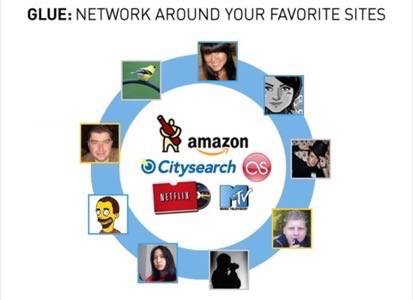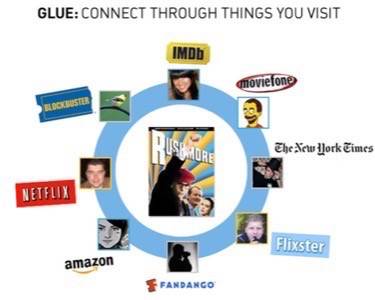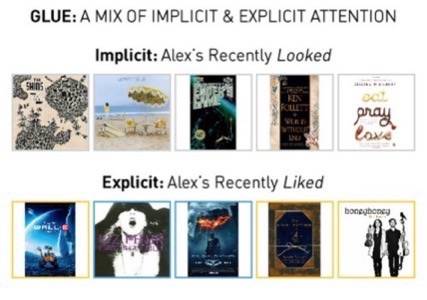Editor’s note: we’re currently running a series of ‘Sponsor Posts’, focused on use cases and technology background. These posts are clearly marked as written by sponsors, but we also want them to be useful and interesting to our readers. We hope you like the posts and we encourage you to support our sponsors by trying out their products.

When we were designing Glue, our goal was to create a simpler way for people to connect around things they are interested in online. In this post we discuss the design choices that we’ve made and why we made them.
1. Bringing the network to the existing content
Paradoxically, even though we live in the age of networks, finding out what your friends think about things is difficult. Whether you are looking at a book on Amazon or movie on Netflix or wine on Wine.com, information about your friends is not there. To get this information you need to go out your way.
Sometimes you have to open another tab and login into a vertical social network, sometimes you have to email your friend, sometimes ping them via chat. There is a lot of friction. The reason for the friction is that content is all over the web, while the networks are silos.
Glue solves this problem by bringing your network to existing content automatically.

With Glue you no longer have to go out of your way to connect. Instead the information about your friends is surfaced right on the page you are visiting – contextually.
2. Connecting across the web and time.
The notion of context is another theme in Glue. We realized that people like to consume information all over the web. Take movies as an example. Some of your friends use Fandango, others use Moviefone. Some are die hard IMDB users, others prefer the more polished look of New York Times movies. Some of your friends rent on Netflix, while others prefer Blockbuster. The point is that people are interacting with the same movie on different web sites.
Glue leverages AdaptiveBlue’s semantic infrastructure to recognize objects across sites. Glue knows that the Dark Knight on IMDB is the same as the Dark Knight movie on Netflix or Amazon or Fandango and dozens of other popular movie sites. Glue automatically folds all these separate pages about Dark Knight movie into a single node and connects people around it.
With the Glue network people enjoy the freedom of interacting with information on the site of their choice, and still benefit from connecting with each other.

In addition to connecting people across the web, Glue also surfaces information across time. It does not matter when your friends interacted with the object, this information is delivered to you contextually. For example, if your friend liked a book 10 days ago, you still want to know about it when you visit this book today. And even if your friend commented on a bottle of wine a year ago, this information is still valuable to you whenever you find this bottle online.
3. Intelligent Lifestreaming
All of us enjoy the new social web, but it also can be overwhelming. The problem is that we rushed to sign up for a lot of services and connected with hundreds of people in each service. We then signed up to monitor lifestreams – the aggregate activity of all friends on all different services. As a result, we have to sift through piles of messages, links, photos, videos, etc.
While this is sometimes entertaining, most of the time it is exhausting. The bits of information that had meaning to our friends at the time when they generated them do not have the same meaning to us. Our brains have to work hard to make sense of information in the lifestreams because it is out of context.
Glue solves this problem by splitting the lifestream information and delivering it only when it makes sense – contextually.

So instead of sifting through the stream of movies that your friends are interacting with all over the web, Glue delivers a subset of this stream into the current page. When you navigate to Dark Knight on IMDB, Glue filters the lifestreams and surfaces information about friends that interacted with this movie. You make the choice what to visit and Glue then shows you relevant bits. You no longer have be the filter, because Glue automatically filters information for you.
4. Positive attention
Finally, we spent a lot of time discussing the levels of participation in Glue. Traditional networks typically have a very small number of users that generate most of the activity, while the rest of the users are passively consuming information. We wanted to invert this equation by making it very easy to participate.
This is why you participate in Glue just by visiting books, music, movies and other everyday things on your favorite sites. Glue automatically remembers the last 20 things you visit, connecting you with your friends around these things. There is no need for you to go out of your way, you are part of Glue when you browse normally around the web.
But implicit attention, while interesting, is not insightful. Your friends want to know what you think about things you visit – did you like them or not? We knew that we needed an explicit mode of participation – a way to express your sentiment.

But we did not want to have complex rating and review system. In today’s age of Twitter, when brevity is golden, we worked out a system which is simple, fun and compact. Glue enables you to either Like an object or add a playful, short comment called 2Cents.
We specifically made the decision to bias the system towards likes because it is more interesting to know what your friends liked than to know what they did not like. Even though you can add a negative comment to something, more often then not, the 2Cents is there for cases when you liked something so much that you are compelled to add a specific comment.
Conclusion
We had a lot of fun designing Glue. We enjoyed debating the way it should work, the way it should look and the way it should feel. We wanted to share with you the decisions behind the product because as a company we firmly believe in openness, transparency and community. We hope that by reading about Glue and using it around the web you are going to get as excited about it as we are and will help us make it better. We are looking forward to your feedback!
Like the sound of Glue? You can sign up here and support a RWW sponsor!










